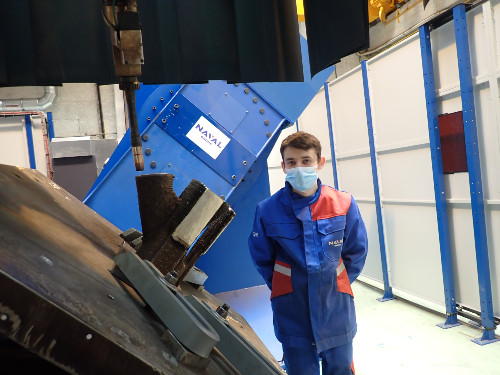How did the manufacturing process for the design contest go?

Théo PETITGAS – Welding Additive
"My work was done in three stages. First, I reconstructed the CAD using the mesh we were provided. Then, I generated the paths on a software program, before creating the robot programs. Finally, I deposited the layers of material to create the part on the machine”, explains Théo Petitgas - Welding-Additive manufacturing Engineer, in charge of manufacturing the part.
What is Wire Arc Additive Manufacturing or WAAM?
This additive manufacturing process is based on the MIG-MAG1 arc welding process which uses a filler metal in the form of wire. It is particularly suitable for the manufacturing of large and/or geometrically complex metal preforms. “The welding robot allows the desired deposition path to be generated. It is a technology that allows great freedom in terms of part size and design and that requires less raw material than a conventional process," explains Anne-Sophie Thorr, Additive manufacturing Welding Engineer at Technocampus Océan. Enough to appeal to many manufacturers! But that’s not all. WAAM has other strings to its bow: the high deposition rate allows for a significant reduction in production time, a relatively low initial investment and a varied (multiple metal alloys available), controlled and easily sourced raw material (welding wire). The latter is a concept that indicates the number of kilos deposited per unit of time, making it possible to classify additive manufacturing processes based on their productivity.
Mastering multi-material WAAM, a challenge
While WAAM for single-material parts has already been mastered and tested for a certain number of metal alloys, the challenge of the Grade2XL project is to develop multi-material WAAM: by changing the filler metal, it is possible to give the part certain specific mechanical properties locally (resistance, anti-corrosion, anti-friction, etc.) and to use a less noble – and therefore less expensive – material for the rest of the part: "This is an opportunity for us to move towards more functional parts and to reduce manufacturing costs," says Anne-Sophie. So, Grade2XL’s partners launched the Design Contest at the end of 2020 to promote the process. The competition, open to young engineering students and researchers, challenged them to design an innovative and manufacturable multi-material product based on the WAAM technology. As a member and co-president of the jury that selected finalists, Naval Group was also responsible for manufacturing the part designed by one of the two winners, Jan Reimann, a German student at the Technical University Ilmenau. Manufactured at the end of May at the Additive Manufacturing unit of the Technical and Innovation department in Nantes-Indret, the part designed by Jan is a structural node (connecting piece between two structural parts). The innovation lies in the topological optimisation of the part: the design is defined in such a way as to distribute the material as accurately as possible in order to guarantee the mechanical strength of the part.
Demonstrators for building up skills
Besides taking part in the Design Contest, Naval Group is also in charge of manufacturing two demonstrators, namely a hydraulic power unit ring holder for EDF and a plastic injection mould for ARRK - large parts with specific characteristics such as the cooling channels integrated in the ARRK mould. “Making these demonstrators has given us the opportunity to build up our skills in the manufacturing and quality control of large parts, as well as in their functionalisation. This includes the possibility of using different materials in certain areas of the part depending on the properties required (anti-corrosion, anti-fretting, anti-abrasion, etc.)" As a result: reduced production times and costs, improved quality, simplified processes, etc. For Naval Group, mastering the multi-material WAAM technology opens up the field of possibilities in new construction as well as in maintenance. And new opportunities for Production too!
(1) Focus on the Grade 2XL project:
Grade2XL is a collaborative project that aims to promote the rapid development of the multi-material WAAM technology. The aim is to demonstrate the potential of this technology for the manufacturing of large structures measuring 1 to 10 metres in length. With a budget of approximately €10 million, €8 million of which is funded by the European research and development program Horizon2020, this project brings together 21 partners from eight European countries. Grade2XL research and development is to run over a period 48 months (from March 2020 to February 2024)
